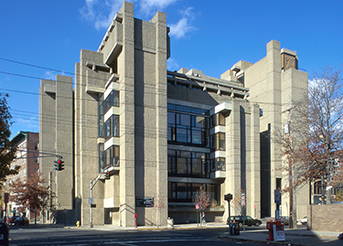
Yale has ambitious goals when it comes to waste, as outlined in the Yale Sustainability Plan 2025. University-wide initiatives target waste diversion, focusing on single-stream recycling and composting in the dining halls. However, these forms of diversion still require significant amounts of energy for processing of materials, which can be avoided if things are simply reused. Yale has demonstrated how creative solutions that rely on innovation and collaboration can establish paths for reuse and foster community connections at the same time.
At the Yale School of Architecture last spring, students found a new waste diversion pathway to address the large volume of design and drafting materials that are typically thrown away at the end of each academic year. Many of the materials, such as drafting boards, drawing tools, and supplies for model-building, were unused and potentially headed for the trash.
Masters students Serena Ching, M.Arch ‘20, and Martin Man M.Arch ’19, spearheaded an effort to divert these items from the waste stream. First, they organized the excess materials to make it easier for architecture students to salvage the materials for their own use. Then, with the help of the Office of New Haven and State Affairs and the Office of Sustainability, Ching and Man connected with a local school—Bishop Woods Architecture and Design Magnet School—that was interested in using the remaining supplies in their “maker space.”
“The teachers from Bishop Woods picked up all of the remaining materials, so we diverted all of our would-be waste,” said Man. “I had been involved with [waste diversion] in high school and college, so I knew that clear communication would be key to getting maximum participation.”
Efforts to redirect waste can also improve communities outside of New Haven. At Yale Health, themes of communication and community collaboration are important to Nanci Fortgang, Associate Director of Clinical Services. She was made aware of a need for medical supplies by NuDay Syria, a humanitarian aid organization based out of New Hampshire that helps communities in Syria and displaced Syrians in the bordering areas.
Fortgang championed an effort at Yale Health to divert items considered waste to help this cause. With assistance from building services and custodial staff, care providers and staff collected excess medical supplies such as gloves, saline, gauze, and crutches to donate to NuDay Syria. McKessen, one of Yale Health’s medical suppliers, also agreed to donate some supplies.
In healthcare facilities in the United States, waste diversion is particularly relevant, as useable medical supplies are often thrown away due to legal concerns or strict FDA regulations.1 While the Yale Health effort with NuDay Syria was a successful spring campaign, two other programs started by Yale-New Haven Hospital physicians, Remedy and Med-Eq, help to resolve this issue on an ongoing basis by diverting materials to communities in need that are able to use the basic supplies.
These types of efforts on campus will help the University reach its new diversion goal: to achieve a diversion rate of 60% by 2024 to align with the State of Connecticut and maintain or reduce the overall amount of waste produced annually since 2017. Other work to support this goal includes a forthcoming “Pay As You Throw” pilot program, increased awareness of recycling best practices, analysis of material flows on campus, and an exploration of emissions associated with purchased goods and services and with waste. Learn more about Yale’s materials management efforts.
Yale is committed to building a more sustainable world. By doing what we do best—integrating science, the humanities, and our community—Yale creates, tests, and adopts innovative solutions to the environmental and social challenges we all face.